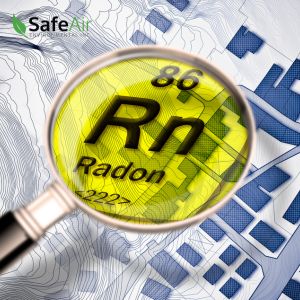What Negative Health Effects Can Radon Gas Cause?
Posted in Radon Testing, on July 19, 2024
For families looking to improve their indoor air environment, home air quality testing is a straightforward way to identify common problems and issues. At SafeAir, we also recommend adding radon testing to the standard package — while this colourless, odourless, invisible gas may not seem like a pressing issue, it can have a cumulatively disastrous effect on human health and is well worth testing for and preventing. In today’s article, we’ll share some of the adverse effects radon gas causes and how testing can help reduce and eliminate unsafe levels.
A Refresher on Radon
 While most homeowners have heard about radon gas, it pays to reacquaint yourself with this natural substance. Radon gas is an invisible, scentless, and tasteless gas created naturally in the environment. It is present in air, water, and soil and, at the levels typically encountered in the environment, is harmless to human health.
While most homeowners have heard about radon gas, it pays to reacquaint yourself with this natural substance. Radon gas is an invisible, scentless, and tasteless gas created naturally in the environment. It is present in air, water, and soil and, at the levels typically encountered in the environment, is harmless to human health.
Radon becomes a problem when we have sustained exposure to high levels. This happens in homes with basements or those built in areas where rocks or water contain high amounts of uranium. Basements create a pocket of negative pressure in the earth’s surface, which draws in and attracts radon gas through cracks and small gaps in the foundation. Once in your home, radon gas can no longer dissipate harmlessly. When radon levels increase above 200 becquerels per cubic metre (Bq/m³), Health Canada suggests taking corrective action within two years to reduce your heightened risk.
The Primary Way Radon Effects Your Health
Since radon gas is undetectable by human senses, you’ll never know you’re breathing it in until it’s too late. Radon particles slip into our bodies through our respiratory tract and mucous membranes. It’s the lungs that take the brunt of the effect, though — after many years of exposure, particles of radon gas create cellular changes that lead to lung cancer and other lung diseases. And it’s not a tiny percentage of unlucky people that are affected — after smoking, radon exposure is the leading cause of lung cancer in North America.
Radon particles hit the lungs and, like other radioactive substances, degrade. During this process, they irritate and inflame the cells of our lungs, causing scarring and damage that lead to lung cancer. While a cancer diagnosis may come years or decades down the road, preventing overexposure to radon particles when you and your family are young will reduce your overall risk.
Who is at Risk of Radon Exposure?
Everyone is exposed to radon gas in the environment. In this sense, radon is harmless because there is enough air and air movement to dissipate the particles before you can breathe in a significant amount. However, several factors increase your risk of exposure and adverse health outcomes:
- If your home has radon levels above 200 Bq/m³.
- If you work in underground mining.
- If you smoke cigarettes.
At SafeAir, we generally place our radon testing device in the basement or lower levels of the home because this is where radon tends to enter the house and where concentration tends to be the highest. This location will be especially significant for families with children, basement apartments, or granny suites.
How to Test for Radon Gas at Home
At SafeAir, we offer radon testing alongside our general home air quality testing or as a standalone service. Radon tests are simple: We come for a quick appointment to place an unobtrusive testing device in the lower level of your home. This device stays in place for 3-6 months, taking passive air samples. It makes no noise or light and should be about as invisible as your carbon monoxide tester.
After testing, we’ll retrieve the device and send it to a lab for analysis. We’ll help you understand the results and make recommendations on radon mitigation and reduction if you need it — not everyone does, but since you don’t know until you test, booking your radon test sooner rather than later is the only way to know. Contact us today to learn more about SafeAir, indoor air quality testing, or radon testing.

